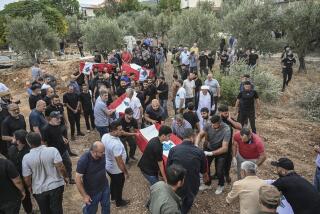Rank-and-File Lebanese Fighters Weary of Violence, Low Pay, Bad Food
BEIRUT — After almost 12 years of civil war, some of Lebanon’s rank-and-file militiamen say they are tired of violence, low pay, bad food and rats as big as cats.
“We want to secure our future,” said Karim Youssef, 25, who lost a leg in a recent skirmish. “For 11 years, fighting has been our daily occupation, and we have no other skills.”
Huge rats scurried about as he huddled with a group of militiamen behind a sand barricade he calls home in the shell-shattered ruins of what was once a high-rise office building near Beirut’s Green Line divide.
“You see, we have live ‘Tom and Jerry’ shows,” he said. “Those rats are our companions, because we have become undesirable in our own communities.”
Spawned by Chaos
Lebanon’s militias are private armies spawned in the chaos of civil war. Some proclaim political ideologies but most fight for Christian or Muslim sects.
No precise figures exist, but at least 50,000 armed men from more than 230 political parties and militias jostle for control of patches of territory. They are seldom challenged by Lebanon’s divided regular army.
Militiamen surveyed by a reporters, however, expressed growing disillusionment with the prolonged sectarian conflict.
They see themselves as victims of the war, much the same as civilians who run the risk of car bombs, shelling and violence in the anarchy of the capital.
Hostile Reactions
“We feel people are hostile to us,” Walid Naem, 28, said. “Most of the time they don’t even give us a lift when they see us in uniform.”
For Jamal, 23, the bond with fellow fighters is stronger than party allegiances in Lebanon’s turbulent, shifting politics.
“We no longer care about politics or who our leaders are,” he said. “But if they ever declare that war is over, they will have to find us jobs and get us back into society. Otherwise there would be a blood bath.”
Many young men unable to find jobs in Lebanon’s shrinking economy join militias simply to support their families.
$30 a Month
Most gunmen questioned voiced fears about the economic crisis, saying that the average wage of $30 a month was barely enough to feed them.
“Food is bad and insufficient,” one fighter, who declined to give his name, said. “Usually we buy some at our own expense. Sometimes we steal it.”
Some militias are ill-disciplined and poorly trained. But the major militias have considerable firepower, including tanks, artillery, multiple rocket-launchers and mortars.
The Muslim Amal militia, comprised of Shia fighters, is the largest, with 12,000 men. It is allied to Syria. Formed in the early 1970s by Iranian-born Iman Musa Sadr, it is now led by Nabih Berri and dominates southern Beirut and southern Lebanon.
Most Formidable Force
The Muslim Druze make up the core of the Progressive Socialist Party militia, which numbers around 7,000 and shares control of West Beirut with Amal. It is led by Walid Jumblatt and is regarded as the most formidable fighting force.
Across the sectarian divide, the Lebanese Forces militia controls Christian East Beirut and parts of the mountainous hinterland. It was welded together from the Christian militias, who fought in the 1975-76 civil war. The group is believed to have 6,000 to 8,000 regulars.
The militia is now led by hard-line anti-Syrian Samir Geagea, who ousted Elie Hobeika early last year after Hobeika signed a peace treaty with the main Muslim militias.
The Green Line has become the traditional battlefront in downtown Beirut and frequent duels between rival militias with artillery, rockets and mortars have turned hundreds of buildings into bullet-scarred ruins.
Streets Emptied
Once-busy streets are now choked with weeds sprouting from shell craters. Cross-fire rattles over a desolate five-mile highway, formerly a vital link through the capital.
Civilians rarely venture near this no-man’s-land. But for the young fighters entrenched there, shared misery and danger sometimes lead to fraternization across the barricades.
“My friends and I received Christmas greetings on our walkie-talkies from our friendly enemies in the militias we fight against,” said Peter Haddad, 25, member of a Christian militia.
“Enemy fighters sometime warn us to keep our heads down when they are about to start shooting,” said another gunman who preferred to remain anonymous.
Some Direct Contact
Periodic reconciliations between Muslim and Christian militia chiefs provide chances of direct contact for their men.
“Bodyguards eat and chat together when their leaders meet. They look like old friends,” said a local journalist who covered reconciliation meetings on the Green Line last year.
Sociologist Mansour Tawfiq warned of grave social consequences if Lebanon’s war continued.
“Thousands of militiamen are still fighting for different causes,” he said. “Hundreds of leaders are struggling to solve problems that are insignificant compared to what might face them and Lebanon in the near future.
More to Read
Sign up for Essential California
The most important California stories and recommendations in your inbox every morning.
You may occasionally receive promotional content from the Los Angeles Times.










